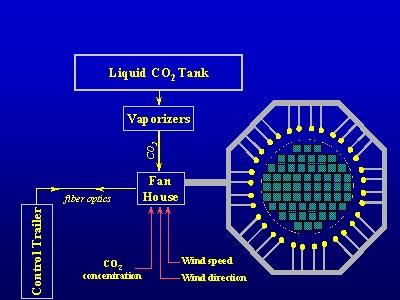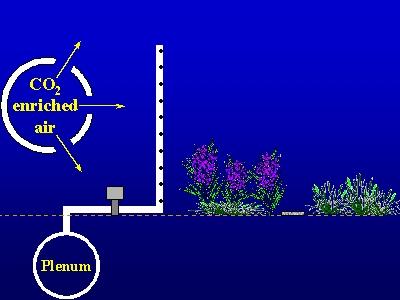BioCON uses a unique Free Air CO2 Enrichment (FACE) technology to elevate the atmospheric concentration of CO2 in the experimental plots. Much research using elevated CO2 has been done in enclosed areas, such as growth chambers and greenhouses where it is relatively easy to control the levels of gasses. There are some limitations associated with these techniques, however. It is difficult to study plants under certain natural conditions, such as temperature, pollination, wind, humidity, and sunlight, within these enclosures. Size of the plant growth and experimental area is also constrained when using these technologies. The FACE system used in the BioCON experiment was developed at Brookhaven National Laboratory. It uses natural wind conditions to carry CO2 enriched air across the vegetation. Because the plants are outside in a more natural environment, the chamber effects normally created by enclosures such as greenhouses are reduced or eliminated.
The BioCON experiment is made up of six fumigation circles. Three of these circles are fumigated with CO2 enriched air. The FACE system is designed to maintain the level of CO2 above the experimental planting at 550 parts per million (ppm), using sensors set up in and near the circles and a central control computer. The remaining 3 circles are ‘fumigated’ with ambient air (~360 ppm CO2) with no experimental CO2 addition in order to protect against erroneous results caused by the experimental equipment. Sensors at each circle continuously transmit information about wind speed and direction, as well as CO2 concentrations above the plots via fiber optics to a control computer. The computer, located in a centralized control trailer, uses this information to calculate the amount of CO2 to release, and which side of the circle to release it on. This information is sent to fan houses located at each circle that contain instruments which adjust the CO2 fumigation equipment.
The amount of pure CO2 added is controlled by a valve inside the fan house. The CO2 then is mixed with ambient air and this mixture is blown by a large fan into an underground pipe, called a plenum, which runs around the plot circle in the shape of an octagon.
To conserve CO2, the enriched air is only emitted on the upwind side of the circles. Every 4 seconds, the control computer relays control instructions to the fan where a system of electronic components open and close large pneumatic valves on vertical emitter pipes installed around the plots (upwind pipes are opened, downwind pipes are closed). After passing through these valves, the CO2 enriched air travels up through the vertical pipes and is emitted through a series of small holes. Natural wind currents distribute the enriched air over and through the plots. When the wind speed is too low to carry the enriched air across the plots, alternating vertical pipes are opened so that small, shifting winds can still distribute the CO2 enriched air.
Because air flow is important to the distribution of the CO2, as much of the infrastructure at the site as possible is buried so as not to obstruct wind. This includes the plenums, CO2 piping, and utilities serving each circle. Any above-ground structure in the field is located at a distance great enough from any fumigation area to prevent disturbance of the air flow patterns.


